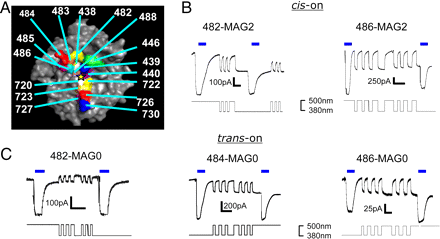
Nanosculpting reversed wavelength sensitivity into a photoswitchable iGluR
Abstract
Canonical NMDA receptors assemble from two glycine-binding NR1 subunits with two glutamate-binding NR2 subunits to form glutamate-gated excitatory receptors that mediate synaptic transmission and plasticity. The role of glycine-binding NR3 subunits is less clear. Whereas in Xenopus laevis oocytes, two NR3 subunits coassemble with two NR1 subunits to form a glycine-gated receptor, such a receptor has yet to be found in mammalian cells. Meanwhile, NR1, NR2, and NR3 appear to coassemble into triheteromeric receptors in neurons, but it is not clear whether this occurs in oocytes. To test the rules that govern subunit assembly in NMDA receptors, we developed a single-molecule fluorescence colocalization method. The method focuses selectively on the plasma membrane and simultaneously determines the subunit composition of hundreds of individual protein complexes within an optical patch on a live cell. We find that NR1, NR2, and NR3 follow an exclusion rule that yields separate populations of NR1/NR2 and NR1/NR3 receptors on the surface of oocytes. In contrast, coexpression of NR1, NR3A, and NR3B yields triheteromeric receptors with a fixed stoichiometry of two NR1 subunits with one NR3A and one NR3B. At least part of this regulation of subunit stoichiometry appears to be caused by internal retention. Thus, depending on the mixture of subunits, functional receptors on the cell surface may follow either an exclusion rule or a stoichiometric combination rule, providing an important constraint on functional diversity. Cell-to-cell differences in the rules may help sculpt distinct physiological properties.